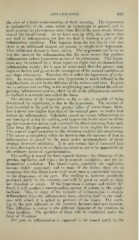Page 683 - My FlipBook
P. 683
INFLAMMATION. 693'
the view of a better understanding of their meaning. The hyperpemia
is undoubtedly of the same nature as hyperseniia in general, and in
itself presents no phenomenon other than that of the most simple dilata-
tion of the blood-vessels. As we have seen (p. 692), this process does
not lead to inflammation, yet here we find it forming a part of the
inflammatory condition. This happens from the tact that in this case
there is an additional element not present in simple local hyperemia.
This additional element is tissue injury. The hypersemia can be in no
way the cause of the inflammation, but the same causes that produce
inflammation induce hyperaemia as one of its phenomena. This hyper-
emia may be induced by a tissue injury so slight that no characteristic
inflammation results ; for it must be understood that this process may
begin to decline and go on to the resumption of the normal condition at
any stage whatsoever. Therefore this is called the hypercemia of irrita-
tion. In severe inflammation this hypersemia is much diffused in the
neighborhood, as seen in the diffusion of the redness and heat. It gives
rise to oedema and swelling in the neighboring parts, without the accom-
panying inflammatory process, which in all of the phlegmonous varieties
is confined to a certain area called the focus.
The elevation of the temperature, so far as this is capable of being
determined by experiment, is due to the hypersemia. The increase of
heat is carried to the part by the greater influx of warm blood ; there-
fore it never rises higher than that of the internal parts, no matter how
intense the inflammation. Cohnheim caused an intense inflammation in
one fore leg of a dog by scalding, and hypersemia in the other by divid-
ing the vaso-motor nerves, and examined the blood returning from each.
That from the hypersemic limb was found to be slightly the warmer.
The mass of experimentation in this direction confirms this observation.
This seems to completely refute the doctrine that the increase of heat in
inflammation is ciiused by the more active metamorphosis of tissue
through increased oxidation. It is now certain that if increased heat
is thus developed, it is to so slight an extent as not to be appreciable by
the ordinary means of experimentation.
The swelling is caused by three separate factors : the dilatation (^f the
arteries, capillaries, and veins ; the hypersemic exudation ; and the in-
flammatory exudation. The blood-vessels, especially the capillaries,
become widely expanded ; and in most of the tissues these are so
numerous that this dilatation in itself must cause a considerable increase
in the dimensions of the part. The swelling is, however, manifestly
produced chiefly by the exudates, and Avill be great or small as these
are abundant or scanty. If the hypersemia is intense and widely dif-
fused, it will produce a corresponding amount of oedema in the neigh-
borhood. This, in many of the varieties of inflammation, is sharply
differentiated from the inflammatory focus, showing itself in the readi-
ness with which it is pitted by pressure of the finger. The swell-
ing in the part inflamed, on the contrary, becomes hard and resistant.
This difference is owing to the different character of the exudates in
these localities. The qualities of these will be considered under the
head of Exudates.
The pain in inflammation is supposed to be caused partly by the


